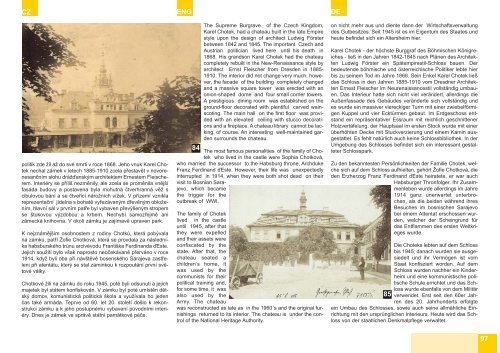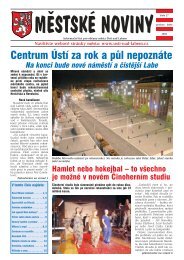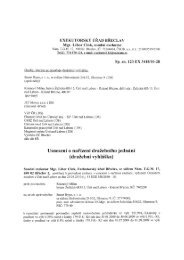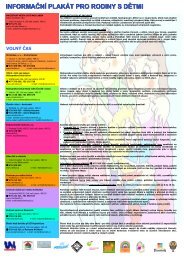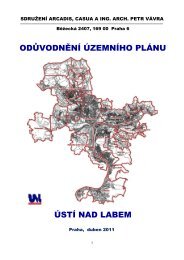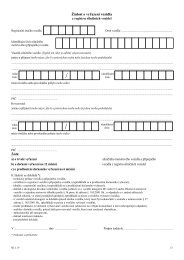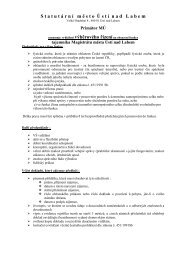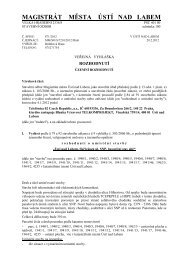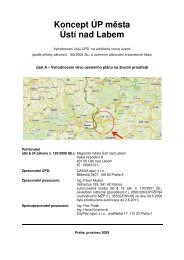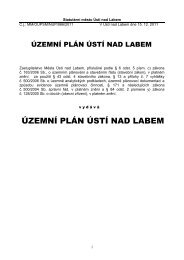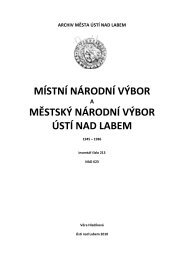Historie a památky města Ústí nad Labem History and monuments of ...
Historie a památky města Ústí nad Labem History and monuments of ...
Historie a památky města Ústí nad Labem History and monuments of ...
Sie wollen auch ein ePaper? Erhöhen Sie die Reichweite Ihrer Titel.
YUMPU macht aus Druck-PDFs automatisch weboptimierte ePaper, die Google liebt.
CZ ENG DE<br />
politik zde žil až do své smrti v roce 1868. Jeho vnuk Karel Chotek<br />
nechal zámek v letech 1885-1910 zcela přestavět v novorenesančním<br />
slohu drážďanským architektem Ernestem Fleischerem.<br />
Interiéry se příliš nezměnily, ale zcela se proměnila vnější<br />
fasáda budovy a postavena byla mohutná čtverhranná věž s<br />
cibulovou bání a se čtveřicí nárožních vížek. V přízemí vznikla<br />
reprezentační jídelna s bohatě vyřezávaným dřevěným obložením,<br />
hlavní sál v prvním patře byl vybaven převýšeným stropem<br />
se štukovou výzdobou a krbem. Nechybí samozřejmě ani<br />
zámecká knihovna. V okolí zámku je zajímavě upraven park.<br />
K nejznámějším osobnostem z rodiny Chotků, která pobývala<br />
na zámku, patří Ž<strong>of</strong>ie Chotková, která se provdala za následníka<br />
habsburského trůnu arcivévodu Františka Ferdin<strong>and</strong>a ďEste.<br />
Jejich soužití bylo však naprosto neočekávaně přerváno v roce<br />
1914, když byli oba při návštěvě bosenského Sarajeva zastřeleni<br />
při atentátu, který se stal záminkou k rozpoutání první světové<br />
války.<br />
Chotkové žili na zámku do roku 1945, poté byli odsunuti a jejich<br />
majetek byl státem konfiskován. V zámku byl poté umístěn dětský<br />
domov, komunistická politická škola a využívala ho jeden<br />
čas také armáda. Teprve od 60. let 20. století došlo k rekonstrukci<br />
zámku a k jeho postupnému vybavení původními interiéry.<br />
Dnes je zámek ve správě státní památkové péče.<br />
84<br />
The Supreme Burgrave <strong>of</strong> the Czech Kingdom,<br />
Karel Chotek, had a chateau built in the late Empire<br />
style upon the design <strong>of</strong> architect Ludwig Förster<br />
between 1842 <strong>and</strong> 1845. The important Czech <strong>and</strong><br />
Austrian politician lived here until his death in<br />
1868. His gr<strong>and</strong>son Karel Chotek had the chateau<br />
completely rebuilt in the New-Renaissance style by<br />
architect Ernst Fleischer from Dresden in 1885-<br />
1910. The interior did not change very much, however,<br />
the facade <strong>of</strong> the building completely changed<br />
<strong>and</strong> a massive square tower was erected with an<br />
onion-shaped dome <strong>and</strong> four small corner towers.<br />
A prestigious dining room was established on the<br />
ground-floor decorated with plentiful carved wainscoting.<br />
The main hall on the first floor was provided<br />
with an elevated ceiling with stucco decorations<br />
<strong>and</strong> a fireplace. A chateau library cannot be lacking,<br />
<strong>of</strong> course. An interesting well-maintained garden<br />
surrounds the chateau.<br />
The most famous personalities <strong>of</strong> the family <strong>of</strong> Chotek<br />
who lived in the castle were Sophia Chotková,<br />
who married the successor to the Habsburg throne, Archduke<br />
Franz Ferdin<strong>and</strong> ďEste. However, their life was unexpectedly<br />
interrupted in 1914, when they were both shot dead on their<br />
visit to Bosnian Sarajevo,<br />
which became<br />
the trigger for the<br />
outbreak <strong>of</strong> WWI.<br />
The family <strong>of</strong> Chotek<br />
lived in the castle<br />
until 1945, after that<br />
they were expelled<br />
<strong>and</strong> their assets were<br />
confiscated by the<br />
state. After that, the<br />
chateau seated a<br />
children’s home, it<br />
was used by the<br />
communists for their<br />
political training <strong>and</strong>,<br />
for some time, it was<br />
also used by the<br />
Army. The chateau<br />
was reconstructed as late as in the 1960´s <strong>and</strong> the original furnishings<br />
returned to its interior. The chateau is under the control<br />
<strong>of</strong> the National Heritage Authority.<br />
on nicht mehr aus und diente dann der Wirtschaftsverwaltung<br />
des Gutbesitzes. Seit 1945 ist es im Eigentum des Staates und<br />
heute befindet sich ein Altersheim hier.<br />
Karel Chotek - der höchste Burggraf des Böhmischen Königreiches<br />
- ließ in den Jahren 1842-1845 nach Plänen des Architekten<br />
Ludwig Förster ein Spätempirestil-Schloss bauen. Der<br />
bedeutende böhmische und österreichische Politiker lebte hier<br />
bis zu seinem Tod im Jahre 1868. Sein Enkel Karel Chotek ließ<br />
das Schloss in den Jahren 1885-1910 vom Dresdner Architekten<br />
Ernest Fleischer im Neurenaissancestil vollständig umbauen.<br />
Das Interieur hatte sich nicht viel verändert, allerdings die<br />
Außenfassade des Gebäudes veränderte sich vollständig und<br />
es wurde ein massiver viereckiger Turm mit einer zwiebelförmigen<br />
Kuppel und vier Ecktürmen gebaut. Im Erdgeschoss entst<strong>and</strong><br />
ein repräsentativer Essraum mit reichlich geschnittener<br />
Holzvertäfelung; der Hauptsaal im ersten Stock wurde mit einer<br />
überhöhten Decke mit Stuckverzierung und einem Kamin ausgestattet.<br />
Es fehlt natürlich auch keine Schlossbibliothek. In der<br />
Umgebung des Schlosses befindet sich ein interessant gestalteter<br />
Schlosspark.<br />
Zu den bekanntesten Persönlichkeiten der Familie Chotek, welche<br />
sich auf dem Schloss aufhielten, gehört Ž<strong>of</strong>ie Chotková, die<br />
den Erzherzog Franz Ferdin<strong>and</strong> ďEste heiratete, er war auch<br />
Habsburger Thronfolger. Ihr Zusammenleben<br />
wurde allerdings im Jahre<br />
1914 ganz unerwartet unterbrochen,<br />
als die beiden während ihres<br />
Besuches im bosnischen Sarajevo<br />
bei einem Attentat erschossen wurden,<br />
welcher der Scheingrund für<br />
das Entflammen des ersten Weltkrieges<br />
wurde.<br />
Die Choteks lebten auf dem Schloss<br />
bis 1945; danach wurden sie ausgesiedelt<br />
und ihr Vermögen ist vom<br />
Staat konfisziert worden. Auf dem<br />
Schloss wurden nachher ein Kinderheim<br />
und eine kommunistische politische<br />
Schule errichtet und das Schloss<br />
wurde ebenfalls von dem Militär<br />
85<br />
verwendet. Erst seit den 60er Jahren<br />
des 20. Jahrhunderts erfolgte<br />
ein Umbau des Schlosses, sowie auch seine allmähliche Einrichtung<br />
mit den ursprünglichen Interieurs. Heute wird das Schloss<br />
von der staatlichen Denkmalpflege verwaltet.<br />
97


